Why Body Boards Are the Perfect Introduction to Wave Riding
Body-board- enthusiasts know that this accessible water sport offers the fastest path from beach beginner to wave rider. Here's what you need to know:
Quick Body Board Basics:
- Size: Board should reach from knees to chin when standing upright
- Core Types: PE (cold water) vs PP (warm water) for optimal flex
- Tail Shapes: Crescent for control, bat for maneuverability
- Essential Gear: Swim fins, leash, and wetsuit
- Best Waves: Start with broken whitewater before progressing to unbroken waves
Bodyboarding traces its roots back to ancient Polynesian paipo boards, with Captain Cook recording Hawaiians riding 3-6 foot boards in 1778. The modern body-board- revolution began in 1971 when Tom Morey invented the first "Boogie Board" using polyethylene foam.
Today's boards range from simple foam designs for beginners to high-performance models with carbon fiber stringers. The average bodyboard measures 100-110 cm (39-43 inches) in length, making it more portable and easier to master than traditional surfboards.
We're American Mortuary Coolers, and as a national-level supplier specializing in precision-engineered equipment, we understand how proper sizing and material selection impact performance - principles that apply whether you're selecting a body-board- for optimal wave riding or mortuary equipment for reliable service.
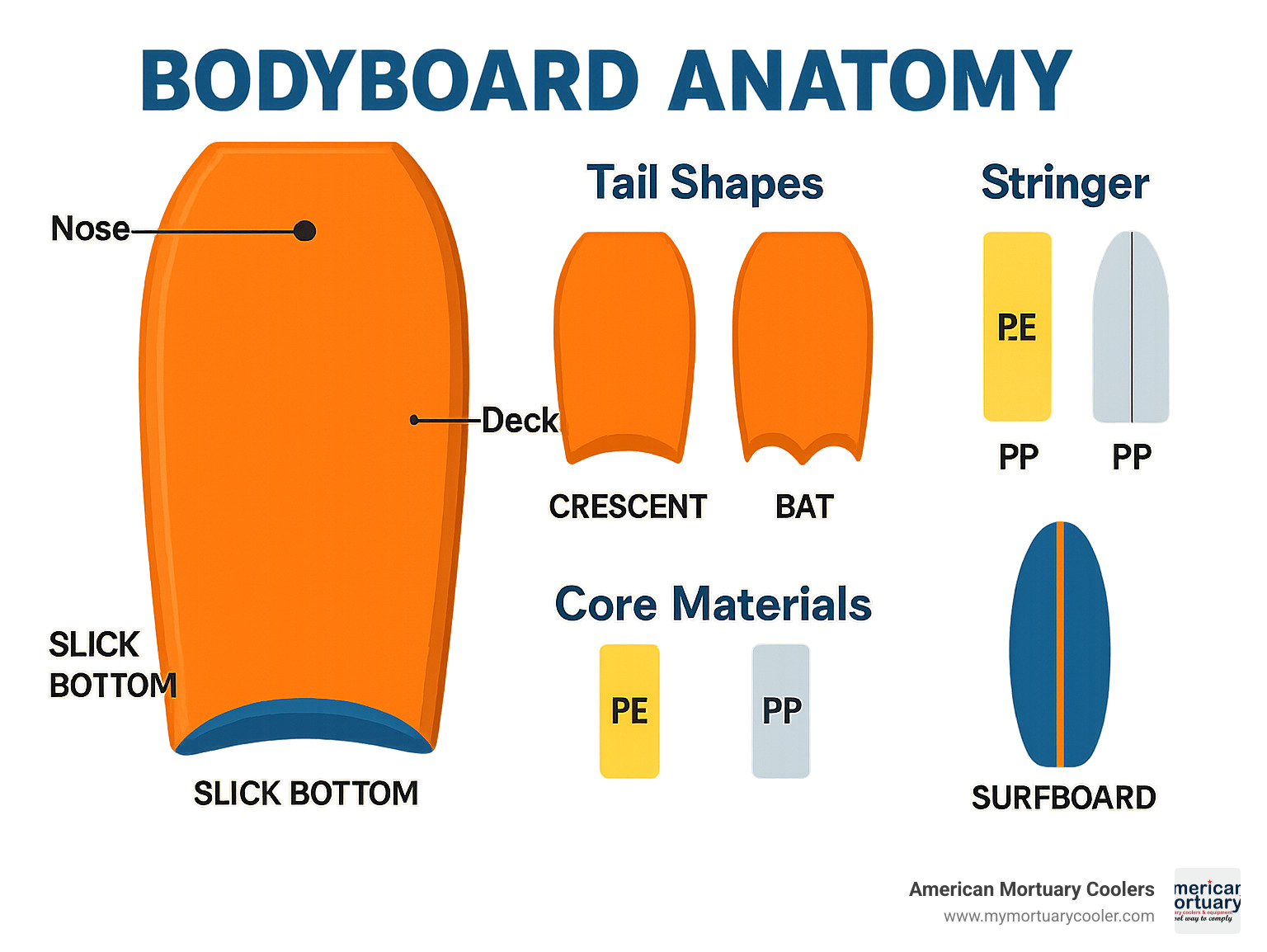
From Paipo to Boogie: A Brief History of Bodyboarding
Picture this: it's 1778, and Captain Cook watches in amazement as Hawaiian riders glide across waves on wooden boards, lying flat on their stomachs. These weren't the first body-board- riders, but they were among the first documented ones in Western records.
The real story starts much earlier with ancient Polynesian surfers who mastered the art of prone wave riding on paipo boards - sleek wooden planks ranging from 90 to 180 cm (3 to 6 feet) long. These weren't just toys; they were carefully crafted from native woods like koa, shaped thin and light for speed across wave faces.
Then came 1971 and everything changed. Tom Morey, a California surfer and inventor, grabbed a piece of polyethylene foam and created the first "Boogie Board" (named after his love of boogie-woogie music). This simple innovation made wave riding accessible to anyone who could swim, regardless of age or athletic ability.
Morey's genius wasn't just the material - it was understanding that most people found traditional surfboards intimidating. His foam board was forgiving, affordable, and fun from day one.
Milestones That Shaped the Sport
The change from Morey's basic foam rectangle to today's high-tech boards happened surprisingly fast. By 1984, manufacturers found that adding fiberglass and graphite stringers turned recreational boards into serious performance equipment.
These stringers - thin rods running through the board's core - created a revolution in speed and maneuverability. Suddenly, riders could generate the stiffness and recoil needed for lightning-fast bottom turns and aerial maneuvers.
Early competitions in the 1980s pushed equipment development even further. When prize money and sponsorships entered the picture, riders demanded boards that could handle bigger waves and more aggressive maneuvers.
The global spread of bodyboarding happened organically as travelers carried their boards to surf breaks worldwide. Unlike surfing, which required years of practice, beginners could catch waves on their first day out. This accessibility helped establish thriving bodyboarding scenes from Australia's Gold Coast to Europe's Atlantic coastlines.
What started as one man's foam experiment became a worldwide phenomenon, connecting modern riders to centuries of Polynesian wave-riding wisdom.
Choosing the Perfect body-board- for Your Size, Skill & Waves
Finding your ideal body-board- might seem overwhelming at first, but it's actually straightforward once you understand the basics. Think of it like finding the perfect pair of shoes - size matters most, but the right style and materials make all the difference.
Board length is where most people start. The classic knee-to-chin rule works great for beginners - just stand the board upright next to you, and it should reach somewhere between your knees and chin. Many experienced riders actually prefer the belly-button rule, choosing shorter boards that hit around their midsection for better control in steep waves.
The width and thickness become crucial if you're heavier than average or surfing smaller waves. More volume means better flotation, which helps you catch waves easier. If you weigh over 180 pounds, focus on finding a wider, thicker board rather than just going longer.
Core materials are simple. Polyethylene (PE) cores work best in cold water because they stay flexible without getting too floppy. Polypropylene (PP) cores shine in warm water, giving you responsive flex without becoming a wet noodle.
Now let's talk tail shapes. Crescent tails offer maximum hold and control, making them perfect for beginners and anyone surfing steep, powerful waves. Bat tails feel looser and more responsive, ideal for advanced riders who want to throw the board around in softer waves.
| Tail Shape | Best For | Characteristics |
|---|---|---|
| Crescent | Beginners, steep waves | Maximum hold and control |
| Bat | Advanced riders, soft waves | Loose, responsive turns |
Sizing a body-board- by Height & Weight
Getting the size right makes the difference between struggling and having a blast. The knee-to-chin measurement gives you a good range to work with, but your experience level should influence where you land in that range. Beginners benefit from longer boards within their size range because they're more stable and forgiving.
Your weight plays a bigger role than many people realize. A 36-inch board suits riders weighing 40-90 pounds and standing between 4'0" and 4'10" tall. On the other end, a 46-inch board works for riders over 220 pounds and taller than 6'4". Getting this relationship right ensures your board floats properly and planes efficiently across the wave face.
Matching Core & Flex to Conditions
Water temperature dramatically affects how your board performs. Cold water requires PE cores to prevent the board from becoming too flexible, which would kill your speed and responsiveness. Warm water calls for PP cores that maintain their flex characteristics without getting overly stiff.
Mesh slick bottoms represent a step up in both performance and durability. The mesh layer creates a stronger bond between the foam core and plastic bottom while allowing manufacturers to fine-tune flex characteristics.
Stringer configuration affects how your board flexes and how long it lasts. Single stringers provide basic reinforcement perfect for recreational use, while triple stringer setups offer maximum stiffness for high-performance riding.
At American Mortuary Coolers, we understand that getting the specifications exactly right matters whether you're selecting a body-board- for optimal wave performance or mortuary equipment for reliable service.
Types, Shapes & Core Materials Explained
When you're exploring bodyboarding, you'll quickly find that not all boards are created equal. Each body-board- design serves a specific purpose, much like how we at American Mortuary Coolers craft specialized equipment for different funeral home needs.
Prone templates form the backbone of bodyboarding, designed specifically for traditional belly-riding. These boards feature wider noses that give you extra paddle power and rock-solid stability when you're learning the ropes.
Drop-knee shapes cater to riders who love the dynamic dropknee stance, where one knee drops down while the other leg extends. These boards typically sport narrower templates with distinctive nose bulbs that provide better grip during rail-to-rail transitions. The legendary Morey Mach 10, first launched back in 1984, remains a crowd favorite among dropknee enthusiasts.
Stand-up hybrids represent an exciting middle ground between bodyboards and small surfboards. These specialized designs let you progress naturally from prone riding to actually standing up on the board.
Channel systems might sound technical, but they're actually quite simple - they're grooves that direct water flow under your board to boost speed and performance. Single channels provide basic water flow control that works great for most riders. Quad channel setups take things to the next level, offering maximum speed and drive through wave sections.
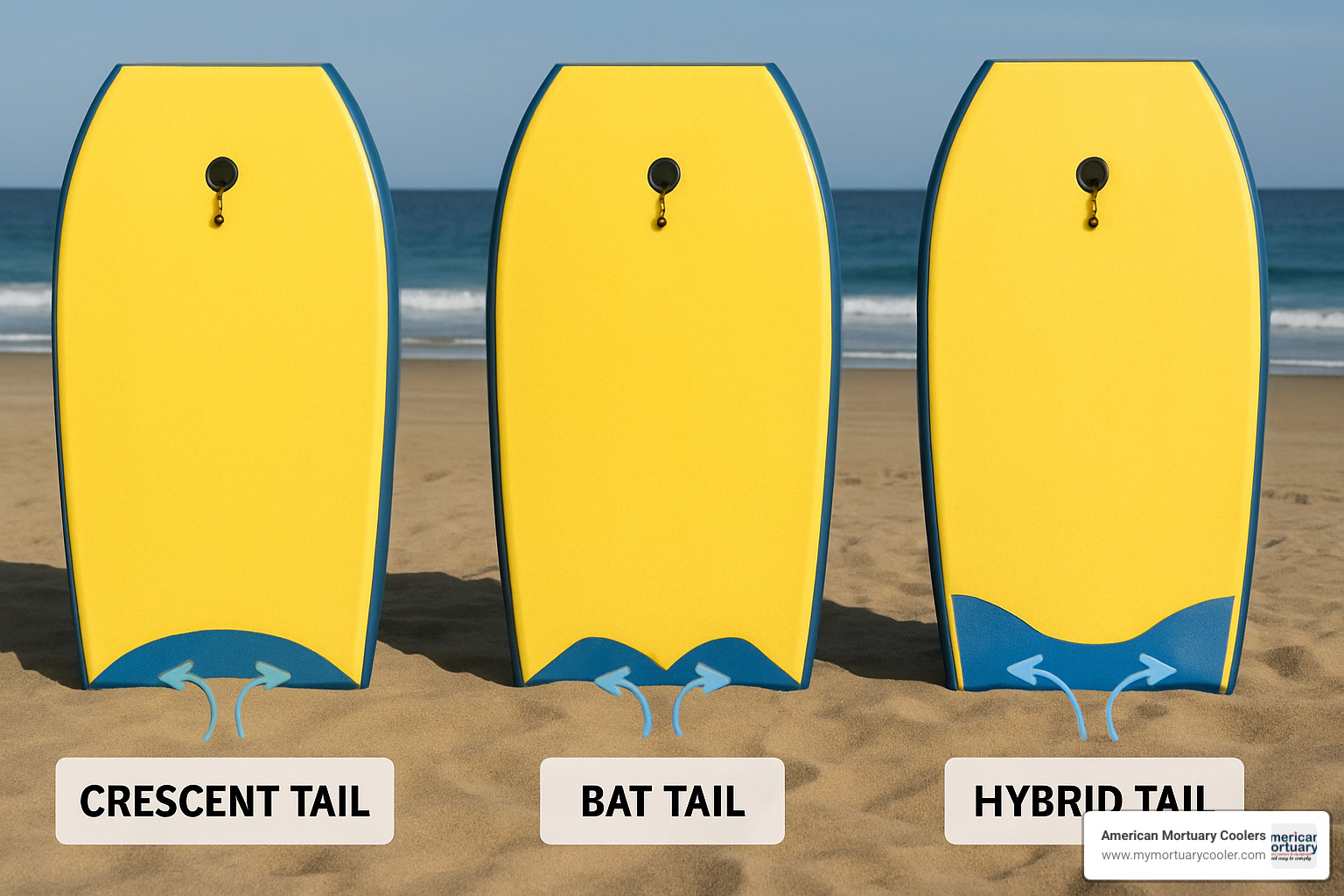
Specialized Designs for Riding Styles
Big-wave guns represent the extreme end of bodyboard engineering. These boards feature increased length, specialized stringers, and reinforced construction built to handle seriously powerful waves. While they sacrifice some maneuverability, they deliver the stability and speed you need when the surf gets intense.
Summer grovelers solve a common problem - how to have fun when the waves are small and less powerful. These boards pack extra width and volume to help you maintain speed in marginal conditions.
Inflatable boards serve specific purposes, especially for young beginners or travel situations. While they can't match the performance of rigid foam construction, they offer important safety benefits for children just learning to glide on waves.
Eco-friendly boards address growing environmental concerns without asking you to compromise on fun. Today's manufacturers offer boards made from recycled materials or featuring biodegradable components.
Essential Gear, Techniques & Safety Tips
Getting started with bodyboarding requires more than just enthusiasm and a board. The right gear transforms frustrating struggles into successful sessions, while proper techniques keep you safe and progressing quickly.
Swim fins are absolutely essential - not optional accessories. They provide the propulsion you need to catch waves and steer currents effectively. Look for fins that fit snugly without pinching your feet during long sessions.
Your leash acts as a lifeline, keeping your body-board- within reach during wipeouts. Modern leashes feature comfortable ankle straps and strong cords designed to handle the forces of powerful waves.
Wetsuits do double duty by maintaining your body temperature and preventing painful chafing from board contact. Choose thickness based on water temperature and your cold tolerance.
Don't overlook fin savers - these simple straps prevent the heartbreak of losing a fin during duck dives or wipeouts.
Learning to duck-dive opens up a whole new world beyond the whitewater zone. Push your board's nose underwater while using your knee or foot to submerge the tail, allowing you to pass cleanly under breaking waves.
Trimming - riding diagonally across a wave face - transforms short, straight rides into long, exhilarating journeys. Angle your board to follow the unbroken section of the wave, maintaining speed and extending your ride significantly.
Wave selection separates great sessions from frustrating ones. Look for waves with curved faces that peel gradually rather than closeout waves that break all at once.
Understanding rip current awareness could save your life. These seaward-flowing channels often appear as different-colored water or foam patterns. If caught in one, swim parallel to shore until you escape its pull.
Surf etiquette keeps everyone safe and happy in the water. Don't drop in on someone already riding a wave, and always maintain control of your board around other surfers.
For comprehensive guidance on getting started, check out this How To Bodyboard For Beginners resource that covers fundamental techniques in detail.
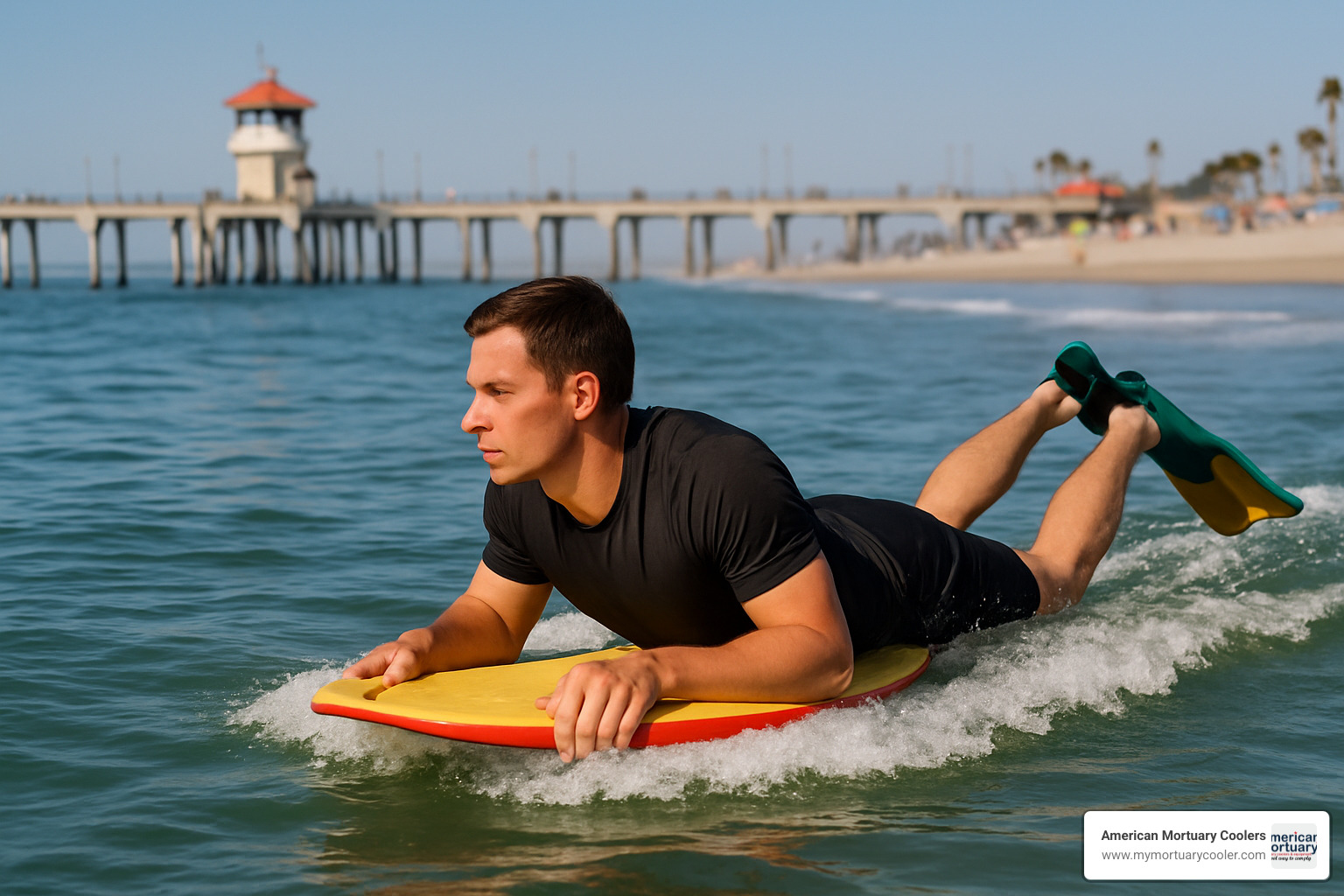
High-Impact body-board- Techniques for Beginners
The kick-paddle combination gives you maximum power for catching waves. Alternate strong arm strokes with powerful fin kicks, keeping your feet underwater to maintain efficiency.
Angling your take-off prevents those disappointing straight-line rides that end quickly in whitewater. As the wave lifts your board, immediately angle toward the unbroken section.
Basic 360-degree spins introduce advanced bodyboarding excitement while remaining achievable for beginners. If you're trying the dropknee stance, you can use weight shifts between rails to perform complete rotations.
Ocean Safety Checklist
Beach flags communicate vital safety information that every bodyboarder must understand. Red and yellow flags mark safe areas with lifeguard supervision, while black and white flags indicate zones restricted to hard-bottom craft like surfboards.
Tidal awareness helps you time sessions for optimal conditions and safety. Rising tides often improve wave shape while increasing water depth over reef breaks. Falling tides can expose dangerous rocks or create stronger currents.
Sun protection becomes critical during water sessions when reflected sunlight intensifies exposure. The buddy system adds an extra layer of safety, especially when exploring unfamiliar breaks or challenging conditions.
Just as we apply systematic safety protocols in manufacturing mortuary equipment, ocean safety requires methodical attention to detail. Our A Practical Guide to Patient Mover Equipment demonstrates how proper equipment selection and safety procedures work together across different industries.
Top Bodyboard Picks for 2025 + Where to Ride
The current bodyboard market offers options ranging from budget-friendly beginner models to premium performance boards costing several hundred dollars. Understanding the distinctions between price points helps riders invest appropriately for their skill level and commitment to the sport.
The Morey Mach 10 continues its decades-long reputation as a dropknee favorite, featuring a narrow template with nose bulbs for improved grip during prone rides. This board's rounded design makes it ideal for riders seeking agility and responsive handling.
Science Pro Tech boards represent the most affordable entry into high-performance bodyboarding. These models incorporate advanced materials and construction techniques previously reserved for premium boards.
The NMD Ben Player Quad showcases cutting-edge channel technology developed by competitive riders. Its specialized bottom configuration provides maximum speed and drive through wave sections while maintaining control for advanced maneuvers.
Pride's Guru Radial FLEX SDC was designed to match the versatile riding style of professional bodyboarder Lewy Finnegan. This board excels across various wave types and riding positions.
For beginners, soft foam boards with plastic bottoms and PE or PP cores provide the ideal combination of safety, durability, and performance. These boards typically cost significantly less than premium models while offering the features needed for skill development.
Price ranges vary dramatically based on construction quality and features. Entry-level boards start around $60, though these basic models lack the performance and durability of quality options. Mid-range boards ($150-250) offer excellent performance for most riders, while premium models ($300-400+) provide professional-level features.
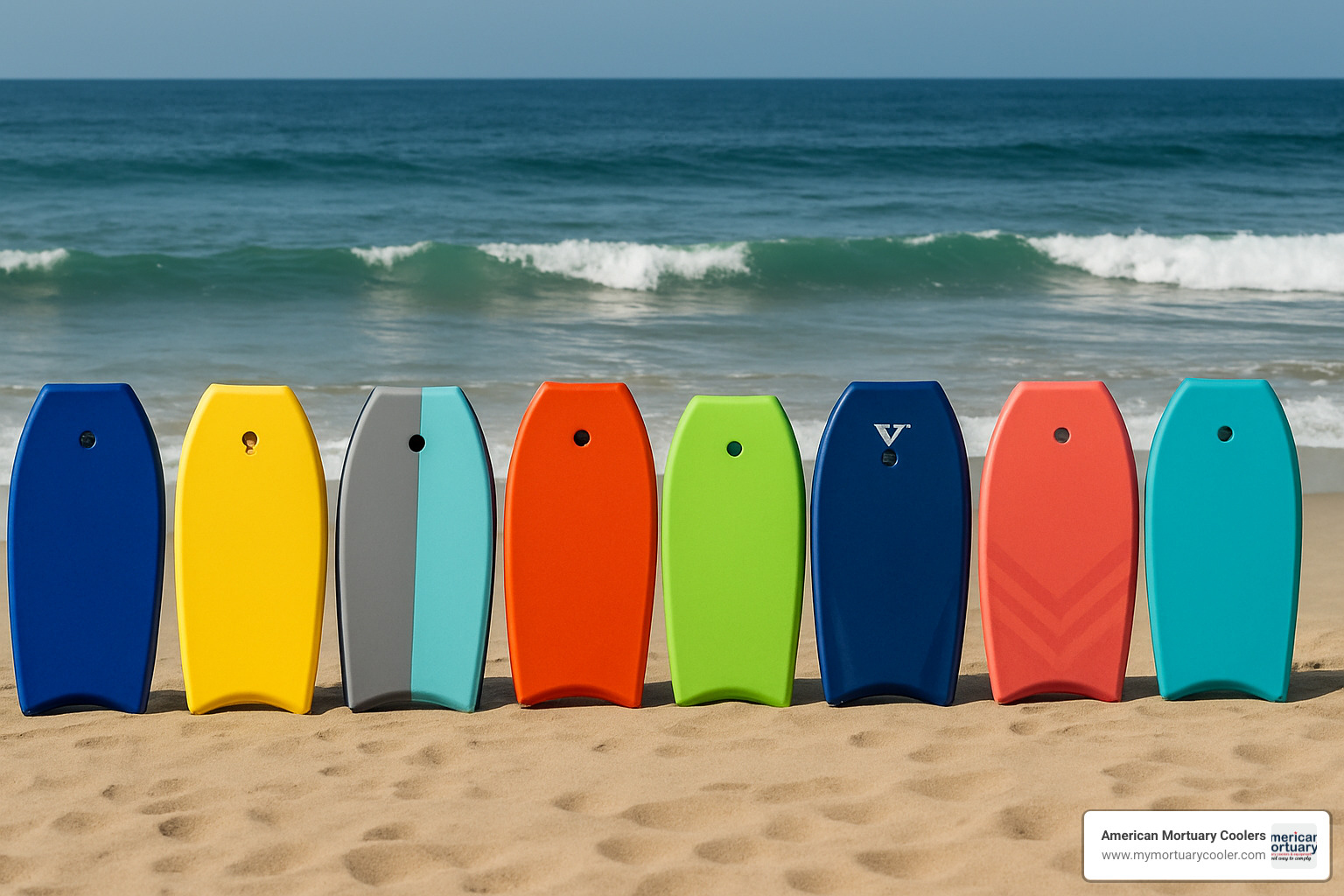
Iconic bodyboarding destinations offer unique challenges and experiences. Pipeline in Hawaii represents the ultimate test of skill and courage, with its powerful, hollow waves demanding expert-level technique. The Wedge in Newport Beach, California, provides a more accessible big-wave experience with its unique wave formation.
International destinations like Iquique, Chile, offer world-class waves in exotic settings. These locations combine perfect wave conditions with cultural experiences, creating memorable trips for dedicated bodyboarders.
High-Performance body-board- Models Reviewed
Advanced boards incorporate sophisticated flex patterns that optimize speed and responsiveness. Manufacturers now rate boards on flex characteristics, helping riders select models that match their riding style and local wave conditions.
Drop-knee specific designs feature narrower templates and specialized rail configurations that accommodate the unique demands of this riding style. These boards often sacrifice some prone-riding performance to optimize dropknee handling.
Travel-friendly options address the needs of bodyboarders who want to bring their equipment on surf trips. These boards balance performance with packability, often featuring removable stringers or specialized construction that withstands airline handling.
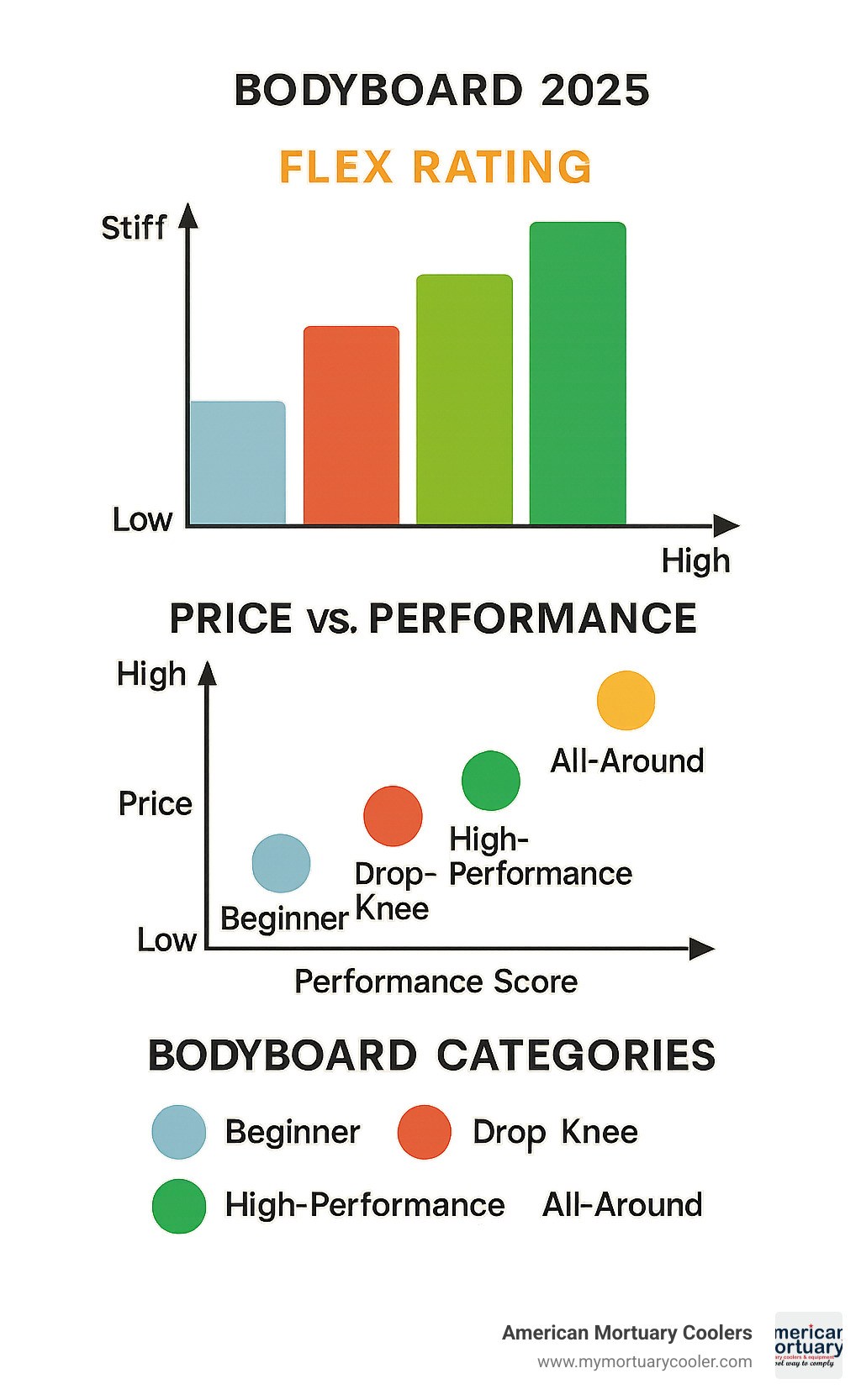
Frequently Asked Questions about Bodyboarding
Getting started with bodyboarding brings up lots of questions, and we've heard them all. Whether you're wondering about the differences between boards or trying to figure out which waves to catch, these answers will help you feel more confident heading into the surf.
What is the difference between a bodyboard and a surfboard?
The most obvious difference is size - your body-board- will be much shorter at 39-43 inches compared to a surfboard's 6-10+ feet of length. This makes bodyboards incredibly easy to carry, store, and maneuver in the water. You won't be wrestling with a massive board trying to get through waves or lugging something heavy across the beach.
The way you ride them couldn't be more different either. With bodyboarding, you're lying flat on your belly, using your arms to paddle and your fins to steer and generate speed. Surfing requires you to pop up and balance on your feet, which takes considerable practice and coordination to master.
Construction tells another story entirely. Bodyboards use flexible foam cores that bend and flex with the wave, while surfboards are built rigid with fiberglass and resin. This flexibility in bodyboards actually helps absorb the impact of powerful waves and makes them much safer for beginners.
The learning curve is where bodyboarding really shines. Most people catch their first wave within their first session, experiencing that incredible rush of riding water almost immediately. Surfing typically requires weeks or months of practice before you're consistently catching waves and staying upright.
How do I read waves to catch the best rides?
Wave reading is like learning to speak the ocean's language, and once you understand the basics, your sessions improve dramatically. The key is identifying waves that peel rather than close out - you want waves that break gradually from one end to the other, creating that perfect curved face to ride along.
Watch the horizon for incoming sets, which are groups of waves that arrive together followed by quieter periods. Most surf spots have predictable patterns - maybe three to five waves per set with two-minute breaks between sets. Position yourself where the best waves in each set will break, not where the smaller ones are already finishing.
Water color gives away secret information about what's happening beneath the surface. Darker, deeper water shows where waves haven't started breaking yet, while lighter, foamy areas indicate where waves have already spent their energy. You want to position yourself right at that transition zone where the wave is just beginning to break.
The shape of the wave face tells you everything about the ride you're about to get. Look for waves with smooth, curved faces that angle away from the breaking section. Avoid waves that look like they're going to break all at once - these "closeouts" will just tumble you around without giving you a proper ride.
Which tail shape should a beginner choose?
For beginners, crescent tails are almost always the right choice. These curved designs work well in just about any wave condition you'll encounter while learning. They provide excellent hold when waves get steep and powerful, but they're also forgiving enough to handle softer, mushier waves without feeling unstable.
The beauty of crescent tails lies in their versatility. As you're learning, you'll encounter all kinds of different waves - some days the surf will be powerful and hollow, other days it'll be soft and rolling. A crescent tail performs well across this entire spectrum, so you won't outgrow your board quickly or feel limited by your equipment.
Bat tails become more appealing once you've developed solid fundamentals and want to explore more dynamic maneuvers. The straighter design allows for quicker rail-to-rail transitions and looser, more responsive turns. However, they require better wave reading skills and more precise positioning to control effectively.
Consider your local break when making this decision. If you're learning at a spot known for powerful, steep waves, the extra hold of a crescent tail becomes even more valuable. If your home break tends toward softer, slower waves, you might progress to a bat tail sooner than riders learning in more challenging conditions.
At American Mortuary Coolers, we understand that getting the right fit for your specific needs makes all the difference in performance and satisfaction. Just as we carefully match mortuary equipment specifications to each client's requirements, choosing the right body-board- tail shape for your skill level and local conditions sets you up for success and faster progression in the sport.
Conclusion
Your body-board- trip doesn't end when you leave the water - proper care keeps your equipment performing like new for years to come. After each session, give your board a thorough rinse with fresh water to wash away salt and sand that can slowly break down the foam core and plastic surfaces.
Sun protection matters just as much for your board as it does for your skin. Extended exposure to direct sunlight causes foam cores to yellow and become brittle, eventually leading to cracks and performance loss. When you're taking a break between sessions, flip your board over or tuck it under an umbrella.
Storage bags are worth the investment if you're serious about bodyboarding. They protect against dings during transport and shield your board from UV damage when stored.
The beautiful thing about bodyboarding is how natural progression feels. Most riders start by riding whitewater straight to shore, then gradually work up to catching unbroken waves. From there, you'll naturally begin experimenting with angling across wave faces and eventually attempting spins or even aerial maneuvers.
Here at American Mortuary Coolers, we've learned that precision equipment requires careful selection and proper care - whether you're choosing a body-board- for optimal wave performance or selecting mortuary equipment for reliable service. Just as we craft custom solutions custom to specific requirements across our locations from Tennessee to California, finding the right bodyboard involves matching specifications to individual needs and intended use.
The parallels between selecting quality bodyboards and professional equipment are actually quite striking. Both require understanding material properties, sizing considerations, and performance requirements. Our experience in precision manufacturing across the Southeast, Northeast, and Pacific regions has taught us that the right equipment, properly maintained, provides years of reliable service.
For riders ready to take their equipment selection seriously, quality construction and proper sizing make the difference between frustrating sessions and years of enjoyable wave riding. Just as we provide detailed guidance for professional equipment selection, thorough research and expert advice ensure your bodyboard investment delivers the performance you expect.
For more insights into precision equipment selection and comparison techniques, explore our More info about sliders & boards guide, which demonstrates how systematic evaluation leads to optimal equipment choices across different industries.
The ocean awaits, and with the right body-board- and knowledge, you're ready to experience the pure joy of wave riding that has captivated humans for centuries.